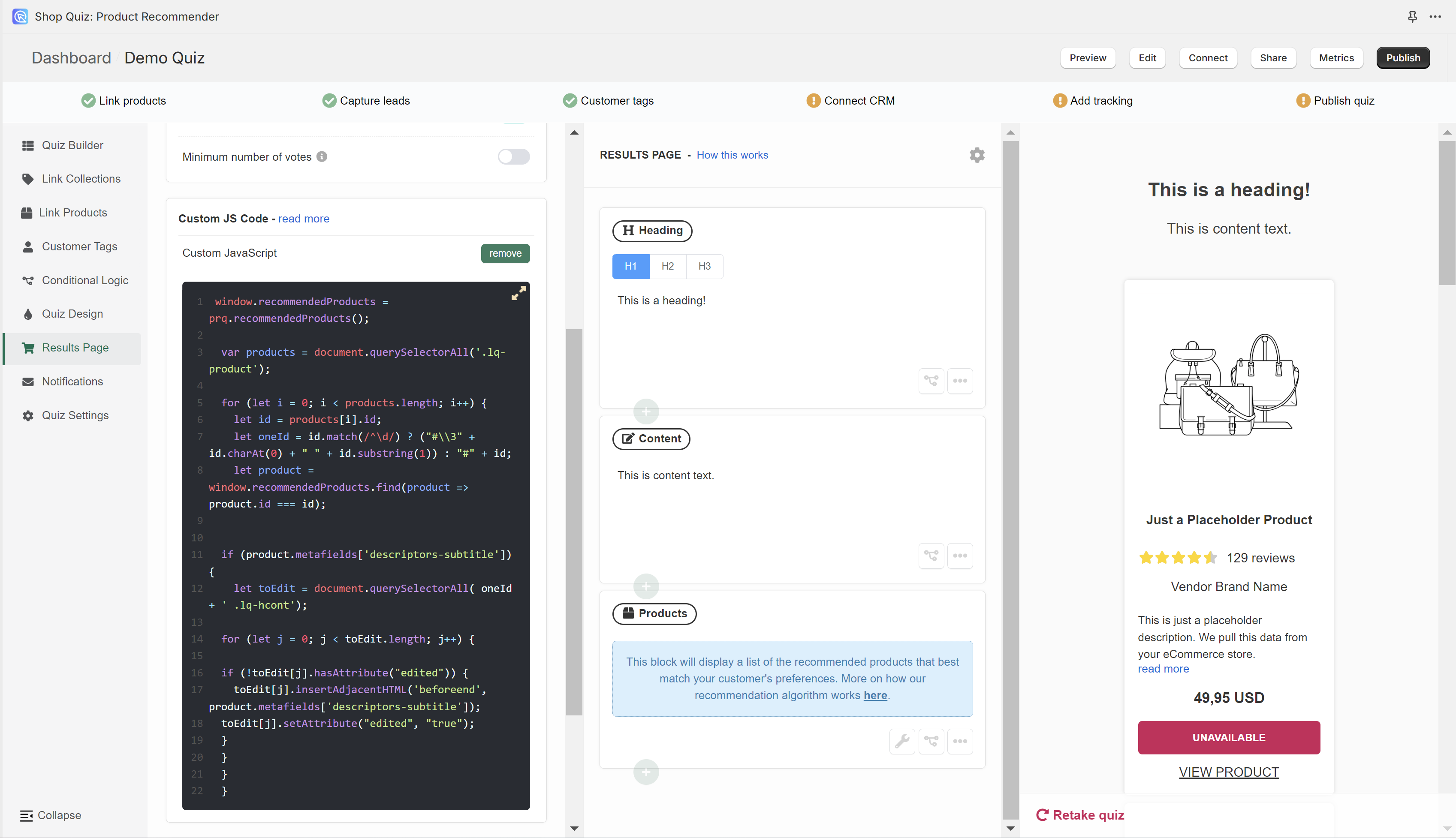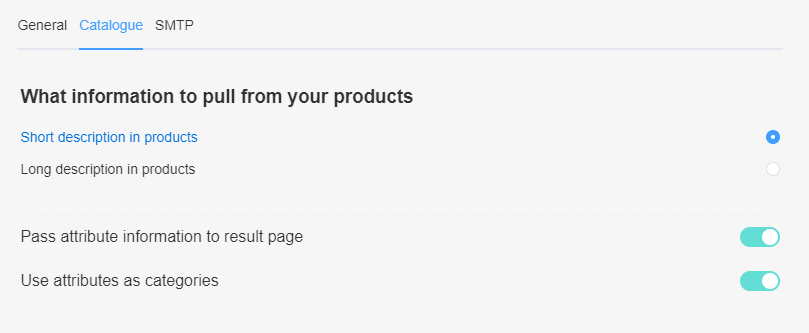How to Add Product Metafields/Attributes¶
This article explains how to add product metafields/attributes to products on your quiz's results page.
Note
The app can only sync and show the custom text product metafields.
Metafields in Shopify are used by stores to display specific product properties that aren't shown by default on e-commerce platforms. For instance, in Germany, it's required to show the "grundpreis" or per 100ml price for cosmetic products. Metafields make this possible.
If you're looking to import product metafields from your store into the Product Recommendation Quiz to display them on your quiz's results page, follow the steps outlined below:
Step 1: Enable Metafields Display
First, enable the display of metafields for individual products:
- Navigate to your Results Page Settings > Basic.
- Open the
Individual Product Settingssection. - Activate the
show metafieldstoggle.

Step 2: Open App Settings
Open App Settings > Catalogue to access the settings to manage your catalog.
Step 3: Select Metafields
Select the Metafields namespaces you want to sync with the app by clicking the toggle icon next to each.

Step 4: Sync the Catalog
Update your catalog with the new metafields by triggering a catalog sync from your dashboard.
Step 5: Implement Custom JavaScript on the Results Page
To display the metafield values on your results page, custom JavaScript is required:
- Your developer will need to write custom JavaScript code to render the metafield value in the desired location on the results page.
- This customization falls outside the support scope of our app.
Here's a sample code that replaces the product description with the descriptors-subtitle metafield. This code should be added in the Custom JavaScript input under Results Page Settings > Advanced Settings:
window.recommendedProducts = prq.recommendedProducts();
var products = document.querySelectorAll('.lq-product');
for (let i = 0; i < products.length; i++) {
let id = products[i].id;
let oneId = id.match(/^\d/) ? ("#\\3" + id.charAt(0) + " " + id.substring(1)) : "#" + id;
let product = window.recommendedProducts.find(product => product.id === id);
if (product.metafields['descriptors-subtitle']) {
let toEdit = document.querySelectorAll(oneId + ' .lq-hcont');
for (let j = 0; j < toEdit.length; j++) {
if (!toEdit[j].hasAttribute("edited")) {
toEdit[j].insertAdjacentHTML('beforeend', '<span>' + product.metafields['descriptors-subtitle'] + '</span>');
toEdit[j].setAttribute("edited", "true");
}
}
}
}

Note
The app can only sync and show the string, single_line_text_field, multi_line_text_field, date, and number product metafields. Rich_text_fields metafields are not currently supported.
Metafields in Shopify are used by stores to display specific product properties that aren't shown by default on e-commerce platforms. For instance, in Germany, it's required to show the "grundpreis" or per 100ml price for cosmetic products. Metafields make this possible.
In Shopify V2, the process for adding and displaying metafields is streamlined. Follow the steps outlined below to import product metafields from your store into the Product Recommendation Quiz and display them on your quiz's results page:
Step 1: Enable Metafields Display
To enable the display of metafields for individual products:
- Navigate to the Results Page tab in the Quiz Builder.
- Add a Product block and open its settings.
- In the
Product components layout, click+ blockand add theMetafieldsection.
- From the
Select metafieldsection, select the metafield you want to display. - Alternatively, you can add a
Textblock to your product layout and add the metafield value manually as a content dynamic source to make it part of a block of text. - Save the changes with the top-right
Savebutton.
From now on the selcted metafiled will be dynamically displayed in the product block as part of the recommended product.
Tip
If you're missing custom metafileds from the list of available metafields, you can force a catalog sync:
- Go to App Settings > Catalogue.
- Click the
Import cataloguebutton to trigger a manual sync.
Attributes in Woocommerce are used by stores to display specific product properties that aren't shown by default on e-commerce platforms. For instance, in Germany, it's required to show the "grundpreis" or per 100ml price for cosmetic products. Attributes make this possible.
If you're looking to import product attributes from your store into the Product Recommendation Quiz to display them on your quiz's results page, follow the steps outlined below:
Step 1: Enable Attributes Display
First, enable the display of attributes for individual products:
- Navigate to your Results Page Settings > Basic.
- Open the
Individual Product Settingssection. - Activate the
show metafieldstoggle.
Step 2: Open App Settings
Open App Settings > Catalogue to access the settings to manage your catalog.
Step 3: Select Attributes
Activate the Pass attribute information to result page setting by clicking the toggle.

Step 4: Sync the Catalog
Update your catalog with the new attributes by triggering a catalog sync from your dashboard.
Step 5: Implement Custom JavaScript on the Results Page
To display the metafield values on your results page, custom JavaScript is required:
- Your developer will need to write custom JavaScript code to render the metafield value in the desired location on the results page.
- This customization falls outside the support scope of our app.
Here's a sample code that replaces the product description with the descriptors-subtitle metafield. This code should be added in the Custom JavaScript input under Results Page Settings > Advanced Settings:
window.recommendedProducts = prq.recommendedProducts();
var products = document.querySelectorAll('.lq-product');
for (let i = 0; i < products.length; i++) {
let id = products[i].id;
let oneId = id.match(/^\d/) ? ("#\\3" + id.charAt(0) + " " + id.substring(1)) : "#" + id;
let product = window.recommendedProducts.find(product => product.id === id);
if (product.metafields['descriptors-subtitle']) {
let toEdit = document.querySelectorAll(oneId + ' .lq-hcont');
for (let j = 0; j < toEdit.length; j++) {
if (!toEdit[j].hasAttribute("edited")) {
toEdit[j].insertAdjacentHTML('beforeend', '<span>' + product.metafields['descriptors-subtitle'] + '</span>');
toEdit[j].setAttribute("edited", "true");
}
}
}
}

Following these steps will enable you to display specific metafields on your quiz's results page, ensuring compliance with local regulations and improving your product presentations.